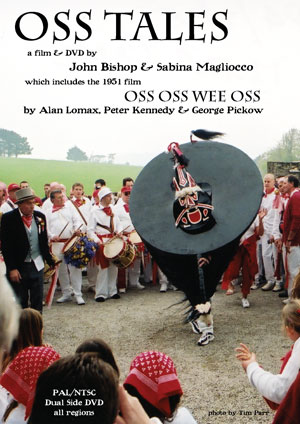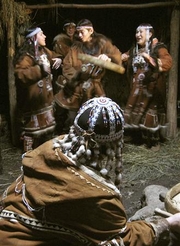
To watch
Oss Tales is to see the difference between a community and a network and the contrast between self-conscious ritual and tradition.
If you are interested in the construction of ritual and of community--and in the history of the Pagan movement--
you should buy the DVD, which contains three short films:
1. "Oss Oss, Wee Oss (1953), an 18-minute documentary of the May Day hobby horse procession in Padstow, Cornwall.
This film was made at the same time when Gerald Gardner & Friends were creating Wicca as the "Old Religion," and you can feel that mental atmosphere when the narrator intones that the procession represents "one of our religions when we lived in caves." There are constant references to the unknowable antiquity of the event. "Some say it's 4,000 year old," says Charlie Bate, a member of the family that traditionally "brings out" the [Red] Oss.
2. "Oss Tales" (2007), filmed at the 2004 Padstow May Day event, and including some of the people from the original documentary and their descendants, by American anthropologist
Sabina Magliocco and filmmaker John Bishop, who compiled this new DVD.
Unlike the 1953 film, which focuses on an unsubstantiated claim that the Oss goes "back to Pagan times," the newer film touches on some of the social and class issues involved. For one, since 1918 there have been
two Osses, the Red and the Blue, and everyone knows who belongs to which faction: "You are born into your color."
The Blue Oss raises money for charity while the Red Oss raises money for beer for its crew. The Blue Oss dances at the manor house while the Red Oss, although invited by the squire, stays in the town. At least the two groups no longer get into fist fights when they meet in the street. Maybe they don't want to scare away the 30,000 tourists.
These and other issues were omitted from the 1953 documentary.
Yet. as the historian
Ronald Hutton notes in a brief appearance, the event has a "really archaic spirit" and has become a "genuinely primitive rite." Without any overt, capital-P Paganism, the Padstow event grabs you by the throat, even through the medium of video.
We also learn that professional folklorists have influenced the event and its interpretations since the 1930s, telling Padstownians that their Oss procession was "the relic of a pagan sacred marriage between earth and sky," as Hutton writes in
The Stations of the Sun: The Ritual Year in Britain (1996). The earliest record of the Padstow procession is from 1803. In fact, the oldest record of a hobby horse in England dates from the Tudor era, the 1500s, and most hobby horse processions in England and Wales are--or were--associated with Christmas and New Year's rather than with May Day.
There is the fertility connection: a woman "covered" by the horse is supposed to become pregnant soon. And there is a death connection: a decoration of graves in the cemetery before the procession.
3. "Oss Oss Wee Oss Redux: Beltane in Berkeley" (2004) runs 14 minutes and was also made by Magliocco and Bishop.
About a dozen years ago, Pagans in Berkeley, California, started their own Maypole-and-Oss tradition in a park. They started by researching Padstow, and as Oss-dancer
Don Frew ruefully admits, they found no clues about
ritual. So they took their
NROOGD Wiccan rituals from the 1960s and added on to them.
After all, while the Padstow procession is ritualized, its rituals are communal, such as which family brings out the Oss. There is no magic circle. But the Berkeley Oss appears in a self-consciously created ritual rather than a pub and the streets. It is a conscious attempt to create tradition and magic. According to some women interviewed, the pregnancy part works, at least.
But this is America, and there is a separation of Oss and state. Participants discourse about rootlessness and ethnic identity and wanting to belong to something.
In Padstow, your family must have lived in town for at least two generations before you can even dance with the Oss. Think how many Californians that provision would disqualify.
One participant flippantly says that after three years, it was an ancient tradition. Maybe, maybe not. If they can keep it going until their grandchildren are doing it, then as Hutton says of Padstow, it will communicate "something genuinely archaic, whatever [its] actual age."
The disk also inclues a "making of" segment and a study guide. It comes in a two-sided NTSC and PAL format for worldwide use.
Labels: Beltane, Paganism
 ¶ Having recently
¶ Having recently  On the Kamchatka Peninsula in Russia's Far East (across from Alaska), indigenous people are engaged in
On the Kamchatka Peninsula in Russia's Far East (across from Alaska), indigenous people are engaged in 




